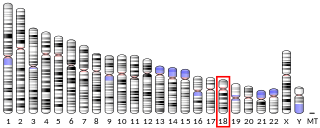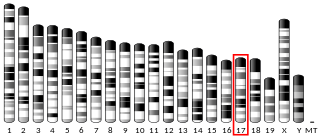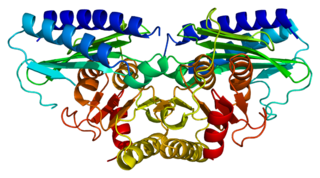
Guanylate cyclase is a lyase enzyme that converts guanosine triphosphate (GTP) to cyclic guanosine monophosphate (cGMP) and pyrophosphate:

Guanylate cyclase 2C, also known as guanylyl cyclase C (GC-C), intestinal guanylate cyclase, guanylate cyclase-C receptor, or the heat-stable enterotoxin receptor (hSTAR) is an enzyme that in humans is encoded by the GUCY2C gene.

Guanylin is a 15 amino acid polypeptide that is secreted by goblet cells in the colon. Guanylin acts as an agonist of the guanylyl cyclase receptor GC-C and regulates electrolyte and water transport in intestinal and renal epithelia. Upon receptor binding, guanylin increases the intracellular concentration of cGMP, induces chloride secretion and decreases intestinal fluid absorption, ultimately causing diarrhoea. The peptide stimulates the enzyme through the same receptor binding region as the heat-stable enterotoxins.

Pituitary adenylate cyclase-activating polypeptide also known as PACAP is a protein that in humans is encoded by the ADCYAP1 gene. pituitary adenylate cyclase-activating polypeptide is similar to vasoactive intestinal peptide. One of its effects is to stimulate enterochromaffin-like cells. It binds to vasoactive intestinal peptide receptor and to the pituitary adenylate cyclase-activating polypeptide receptor.
A guanylate cyclase activator is one of group of proteins which upregulates guanylate cyclase. It is also known as guanylate cyclase-activating protein, with the abbreviation "GCAP". Mutations can be associated with vision defects.

Activating transcription factor 6, also known as ATF6, is a protein that, in humans, is encoded by the ATF6 gene and is involved in the unfolded protein response.

Natriuretic peptide receptor B/guanylate cyclase B , also known as NPR2, is an atrial natriuretic peptide receptor. In humans it is encoded by the NPR2 gene.

Natriuretic peptide receptor C/guanylate cyclase C , also known as NPR3, is an atrial natriuretic peptide receptor. In humans it is encoded by the NPR3 gene.

Guanylyl cyclase-activating protein 1 is an enzyme that in humans is encoded by the GUCA1A gene.

Heat-stable enterotoxins (STs) are secretory peptides produced by some bacterial strains, such as enterotoxigenic Escherichia coli which are in general toxic to animals.

Inositol monophosphatase 2 is a 32 kDa enzyme that in humans is encoded by the IMPA2 gene. IMPA2 dephosphorylates myo-inositol monophosphate to myo-inositol.

Guanylate cyclase soluble subunit beta-1 is an enzyme that in humans is encoded by the GUCY1B3 gene.

Protein CREG1 is a protein that in humans is encoded by the CREG1 gene.

Guanylyl cyclase-activating protein 2 is an enzyme that in humans is encoded by the GUCA1B gene. Alternative names:

Guanylate cyclase soluble subunit alpha-3 is an enzyme that in humans is encoded by the GUCY1A3 gene.

Guanylate cyclase soluble subunit alpha-2 is an enzyme that in humans is encoded by the GUCY1A2 gene.

ATP-binding cassette, sub-family C member 9 (ABCC9) also known as sulfonylurea receptor 2 (SUR2) is an ATP-binding cassette transporter that in humans is encoded by the ABCC9 gene.

Uroguanylin is a 16 amino acid peptide that is secreted by enterochromaffin cells in the duodenum and proximal small intestine. Guanylin acts as an agonist of the guanylyl cyclase receptor guanylate cyclase 2C (GC-C), and regulates electrolyte and water transport in intestinal and renal epithelia. Its sequence is H-Asn-Asp-Asp-Cys(1)-Glu-Leu-Cys(2)-Val-Asn-Val-Ala-Cys(1)-Thr-Gly-Cys(2)-Leu-OH.

Retinal guanylyl cyclase 2 also known as guanylate cyclase F (GUCY2F) is a protein that in humans is encoded by the GUCY2F gene.
Scott A. Waldman is an MD and biomedical scientist at Sidney Kimmel Medical College of Thomas Jefferson University, where he is the Samuel M.V. Hamilton Professor of Medicine, and also tenured professor and chair of the Department of Pharmacology & Experimental Therapeutics. He is author of a pharmacology textbook, and former chief editor of Clinical Pharmacology & Therapeutics. He is known for his work in atrial natriuretic factor intracellular signaling through guanylate cyclase (GC), and the relation of Guanylyl cyclase C (GC-C) to the pathogenesis of colorectal cancer. Also for his hypotheses concerning the roles of intestinal paracrine hormones in satiety, obesity and cancer risk. Waldman also holds a concurrent position as adjunct professor at the University of Delaware, School of Health Sciences.



















